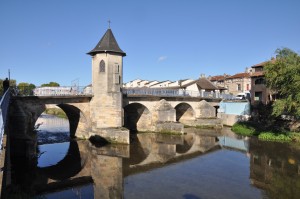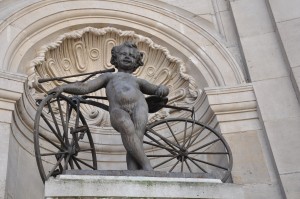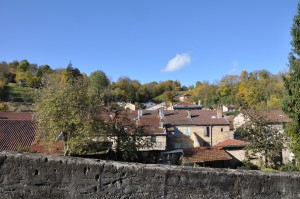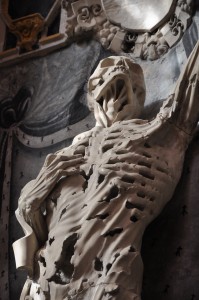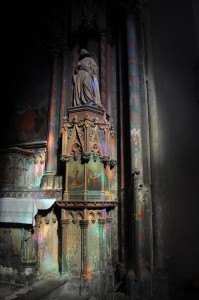I knew there was an upper town and a lower town in Bar-le-Duc; I was a little less clear on the difference in elevation.
The Ornain and its fellow waterway the Canal of the Marne cut through the town’s steep hillsides from northwest to southeast. They plus a few smaller canals lend certain ancient quartiers the atmosphere of Venice. We left the Office de Tourisme blinking in the pure light of a perfect October morning. At sunrise there was not even a hint of mist in the valley behind our gîte l’Alambic; every leaf of red and gold on the distant hills, it seemed, was visible absent the slightest suggestion of blue haze. A few clouds lounged low in the sky. The only element amiss in this paysage Lorraine was the futuristic vanes of the windmills that sprouted from the fields.
A Roman settlement in the first century BCE, a fortress in the tenth, Bar-le-Duc became a proper town in the thirteenth century and a grand society in the sixteenth under the patronage of Ducs René I and II of Anjou. It helped that relations with Kings Antoine the Good and Charles III of France were peaceful. In the seventeenth century the Thirty Year’s War with its military occupations and concurrent famines and epidemics brought the town to its knees. Cardinal Richelieu connived for Lorraine’s annexation to France, a feat accomplished in 1766 just in time for the French Revolution. Bar-le-Duc prospered in the 19thcentury. Its breweries turned grain into beer; key industries included textiles and ironworks.
The brothers Pierre and Ernest Michaud invented the pedal velocipede to which proud accomplishment a monument was erected by public subscription in 1894. With the outbreak of World War I in 1914, Bar-le-Duc became a key part of the French defense. Just south and west of the Front and the bulge of the St. Michael Salient, it was the terminus of the road to Verdun, the avenue soon to be named the Voie Sacrée, the Sacred Way. It was a munitions and supply depot for the troops and an important military center for the French army and later the American Expeditionary Force.
It was a stopover for Pop en route to his first assignment, the ambulance cantonment at Dombasle and the nearby postes de secours, the aid stations at Montzéville, Esnes, and Avocourt. It was the location of a training school to which David was sent in the spring of 1918, just prior to the Aisne-Marne Offensive in the summer and the St. Mihiel Offensive in September. In a diary entry dated April 15, 1918, Pop wrote:
We rose sleepily at 4:30 and hastened in the semi-darkness to the old town pump for the morning wash. It was a very picturesque scene, with an old ruined monastery rising up majestically against the blue, mysterious sky, a hundred yards behind the little square where the pump was located.
A little narrow street rose steeply at an angle behind the square and I walked to the corner to see if I could get a glimpse of the monastery. The view down or rather up the little narrow street with its overhanging houses was one of the most beautiful and unexpected things I have ever seen. The bright half moon shone clearly and steadily, outlined against the sky between the quaint chimney tops. It was perfect and in the still, grave-like hush of pre-dawn it was bewitching. Coming back to the cars, I passed over a little bridge that crossed a sort of canal that flowed sleepily along between the houses, lapping the walls with a faint splashing that alone broke the stillness. One end of this canal was blocked in some way by the wall of a church in which were set two beautiful stained-glass windows.
Pop summarized it as being “all like a bit of dream Venice.” “Venice” was our thought as well as we crossed over a small canal on the Rue du Bourg and looked at the houses riddled with damp. It could have been the same canal, the same view. The church of St. Antoine is located on that canal and might have been the church he referred to. I wish I had had this passage in mind while walking in Bar-le-Duc, but only now in writing this did I return to the transcript of his diary.
We walked up and up, my Dear One and I, my goal being the Church of St. Étienne with its famous sculpture by Ligier Richier and his goal being making it at all. At last we reached the summit and… oh no! A sign said the church is closed until next March! I howled in dismay. A gray-haired gentleman scurried up, flourished a key and unlocked the door and encouraged us to take our time. We did, bless him.
St. Étienne is a small church, almost like a reliquary. The walls are curtains of stained glass and the proportions are modest. Richier’s sculpture occupies a corner at the south corner of the choir. It is frightening in its Gothic eeriness and charming in its Renaissance humanism. I looked at the hand elevated in rhetorical gesture and thought Shakespeare would have had a giggle. The language of memento mori—“as you are now so once was I; as I am know so you will be”—was less in my mind than the Bard’s comment, “Alas, poor Yorick. I knew him well, Horatio.”
And what I really remembered was my mother’s teenaged variation of the theme in a cautionary image painted in reference to the unreliable plumbing at Squam Lake. A woman stands triumphant with rolling pin over the prone form of an unconscious man. The caption reads, “Alas poor Yorick, now he’s gone. / He threw his cigar in the upstairs john.”
We wound our way down from the Ville Haute, stopping for crepes and coffee before heading back to the car. As we passed Notre Dame—whose dim interior we had already explored—we felt the thunder of organ music and went back in. It lasted only a few minutes, sounds that washed over me and compressed my lungs in time with the bellows in the instrument. I did not recognize the compositions or composers but I let that mighty sound transcend all else. Then it stopped and a slender young man, dark-haired and darkly clad, leapt down the steps from the organ loft and headed off in the direction from which he had just come before we could thank him for that concert.

